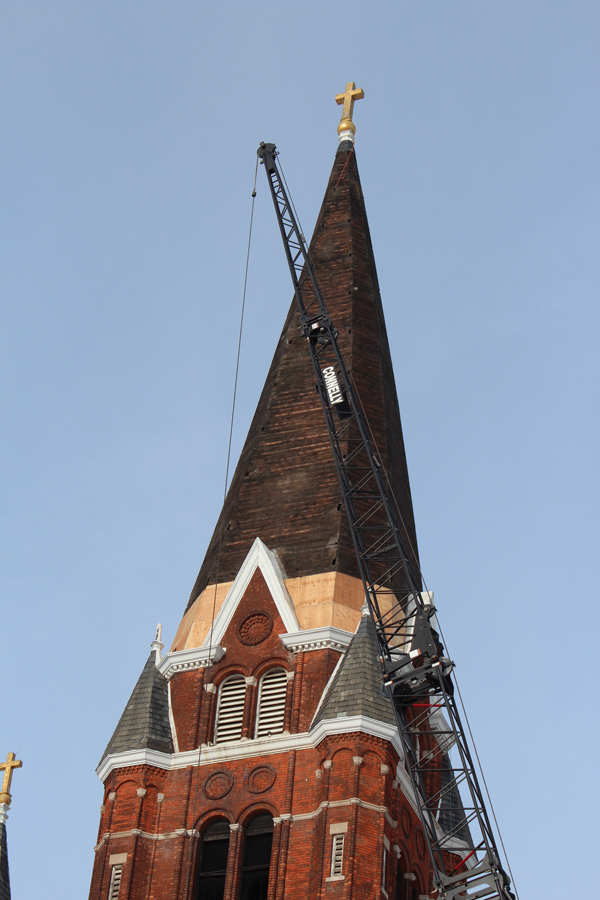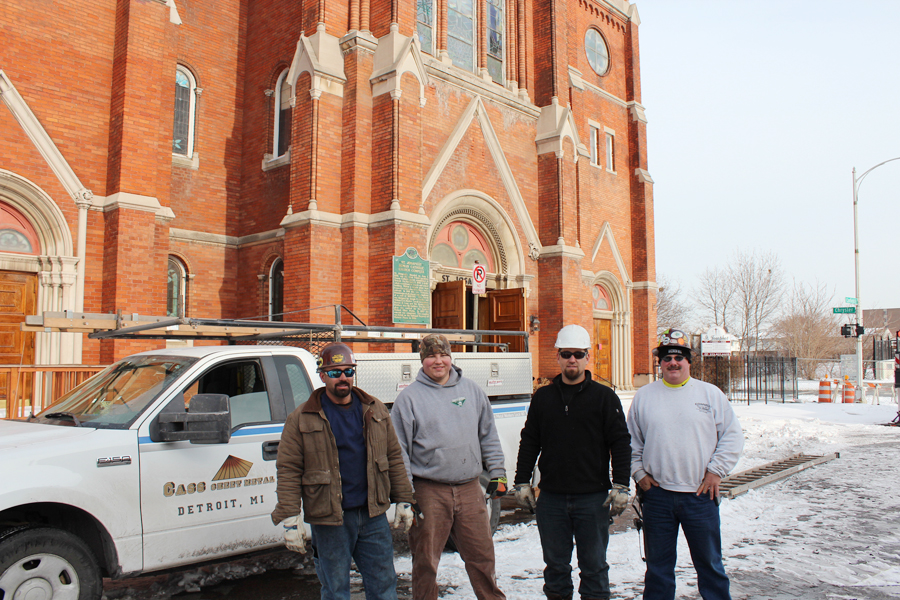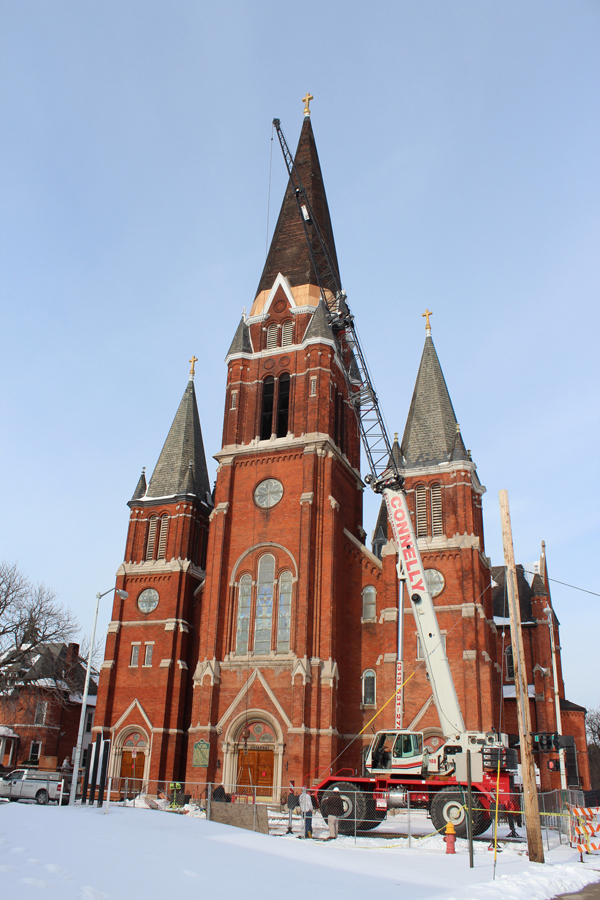Quick work saves iconic church steeple
Date Posted: January 17 2014

DETROIT – Thanks to the skills of Local 80 craftsmen from Cass Sheetmetal, an historic church in Detroit now has a stable steeple. A wind storm that blew through Michigan on Nov. 17 nearly toppled the main 90-foot steeple that towers 215 feet above St. Jospahat Church. Built in 1901, the iconic steeple is a beacon visible to drivers along I-75 at Canfield, but it was knocked off its moorings by winds that reached 60 miles per hour in the area, which also knocked out power to about 134,000 homes and businesses.
“After working on and re-securing timbers in the structure of the steeple, I felt reasonably assured that the next 50-to-60 mile-per-hour wind gust would have finished the job,” said Glenn Parvin, owner and president of Cass Sheet Metal, whose team was able to temporarily stabilize the structure. The City of Detroit’s Building Department wanted a stabilization, repair or demolition plan for the steeple within three days after the windstorm. Cass won the bid to attempt to stabilize the steeple, even though at the outset it wasn’t entirely clear what needed to be done to re-anchor the leaning structure.
The church’s leaders accepted Parvin’s bid, which he described as an “open book proposal” with a fee structure that would be applied depending on what was found when a closer inspection of the steeple could be made.
To make that inspection, Cass Sheet Metal responded within 16 hours of authorization with a 220-foot crane and man-basket that was used to inspect and remove loose slates and access the outside structure. On the inside craftsmen had to build a temporary work station that would provide the base for a 32-foot ladder to reach further up into the steeple for structural repair and anchor points.
The structure of the steeple’s interior is made up of crossed timbers, and what the Cass crew found is that the structure failed because nails holding the bracing down in about 50 places had popped and failed, as well as splitting the diaphragm at the base.
The crew found that the steeple top moved horizontally about two feet. The winds blew a hole in the steeple’s side, slate tiles were blown off, and the structure became deformed. The hazard led to the area around the church being cordoned off, and the church itself closed.
The stabilization work was hazardous, and safety was the first priority. A kickoff safety meeting was held with the crew, owners, structural engineer, the owner and the crane operators to develop a safe plan and order of priority in the stabilization effort that was to proceed.
The wind was their big enemy. “It would move in the wind, and you could hear the creaking and groaning,” said Chuck Collar, foreman and Local 80 Sheetmetal worker for Cass. “The wind would just freak you out.” He said the steeple “was moving more than I wanted to see” on two days when there was 25-mile per hour gusts, so the job was shut down during those times.
The stabilization plan evolved quickly. Cass workers decided to use criss-crossed steel cables and turnbuckles woven through the steeple’s lumber interior. Heavy gauge sheet metal strapping and plywood were installed to stabilize the steeple’s hip joints. An additional deck was constructed at the 150-foot level to provide access further up the steeple where many support bracing members required reattachment. All the work took several days, and the steeple no longer moved in the 30 mpg wind gusts that occurred the day before Thanksgiving – providing a huge sigh of relief for all parties involved.
The slate exterior of the steeple was completely removed during the stabilization effort. Cass completed this initial phase of their work on Dec. 19, and awaits a decision on the future of the steeple.
A spokesman for the Archdiocese of Detroit late last month said the steeple’s situation remained “in a holding pattern,” awaiting the final word on the insurance payment and fundraising efforts. He said there was some “great work” done by Cass Sheet Metal to stabilize the steeple. Church officials were also awaiting the assessment of a structural engineer, and the cost on various options involving the steeple, including restoration, replacement or removing the steeple and capping the opening.
A Dec. 23 article in the Michigan Catholic said St. Josaphat is part of the three-church Mother of Divine Mercy Parish, which also includes nearby Sweetest Heart of Mary Church – an historic church that has its own spires in need of repair.
Kevin Piotrowski, parish council president, told the Michigan Catholic that ideally, the parish’s short-term goal for its “Save Our Steeples” fundraising campaign is to “raise as much money as possible so that we can essentially rebuild the steeple at St. Josaphat.”
“The longer-term goal is to have funding so that we can also address the steeple needs at our other churches as well,” he said. “At St. Josaphat, we have a time-frame where we’ve only got really into maybe January because we have to take some sort of action.”
Parvin said he was proud of the difficult job our team did. “We responded and did what we needed to do with the planing and the rigging and the hoisting to get the structure stable,” he said. “It wasn’t easy but we did what we needed to do.”

AMONG THE CREW working on the St. Josaphat steeple project for Cass Sheet Metal were (l-r) Chuck Collar, Kyle Adams and Eric Brady, all of Sheet Metal Workers Local 80, and crane operator Mike Lezotte of Operating Engineers Local 324.

Detroit St. Josaphat Church's 90-foot main steeple isn’t plumb, but it’s currently stable."

St. Jospahat was built by Detroit's Polish community in 1891.
